July 17, 1975. Just shy of the sixth anniversary of the first Moon landing, the culmination of the space race between the United States and the Soviet Union, an American spacecraft docked with a Soviet capsule in Earth orbit as part of the Apollo-Soyuz Test Project (ASTP). The docking took place two days after the two spacecraft launched from their respective launch sites. During two days of docked operations, crewmembers from the two former competitors opened the hatches between the two spacecraft, shook hands, shared meals, held press conferences, and conducted joint science experiments. The spirit of cooperation resulted from the policy of détente between the two superpowers. Technology, processes, and relationships developed for ASTP contributed to the success of future programs such as Shuttle-Mir and the International Space Station.
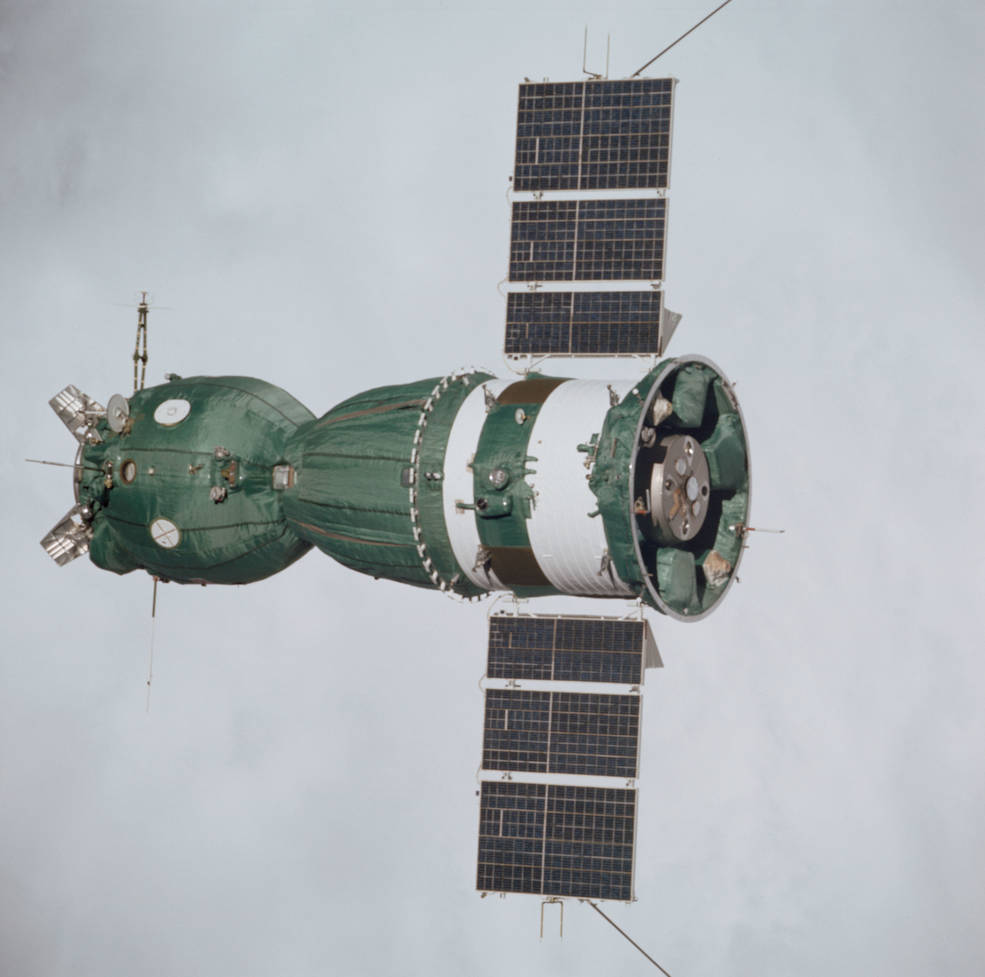
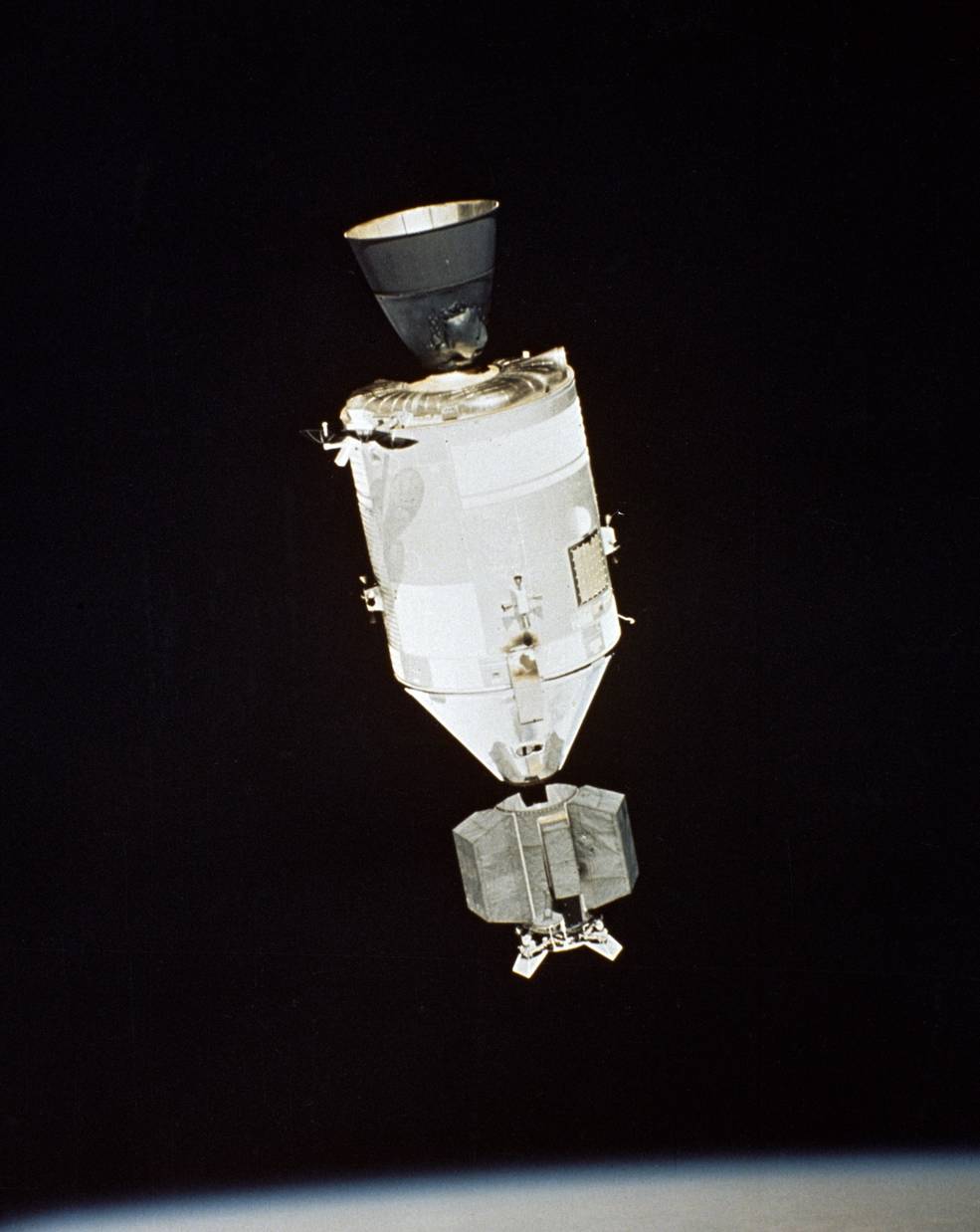
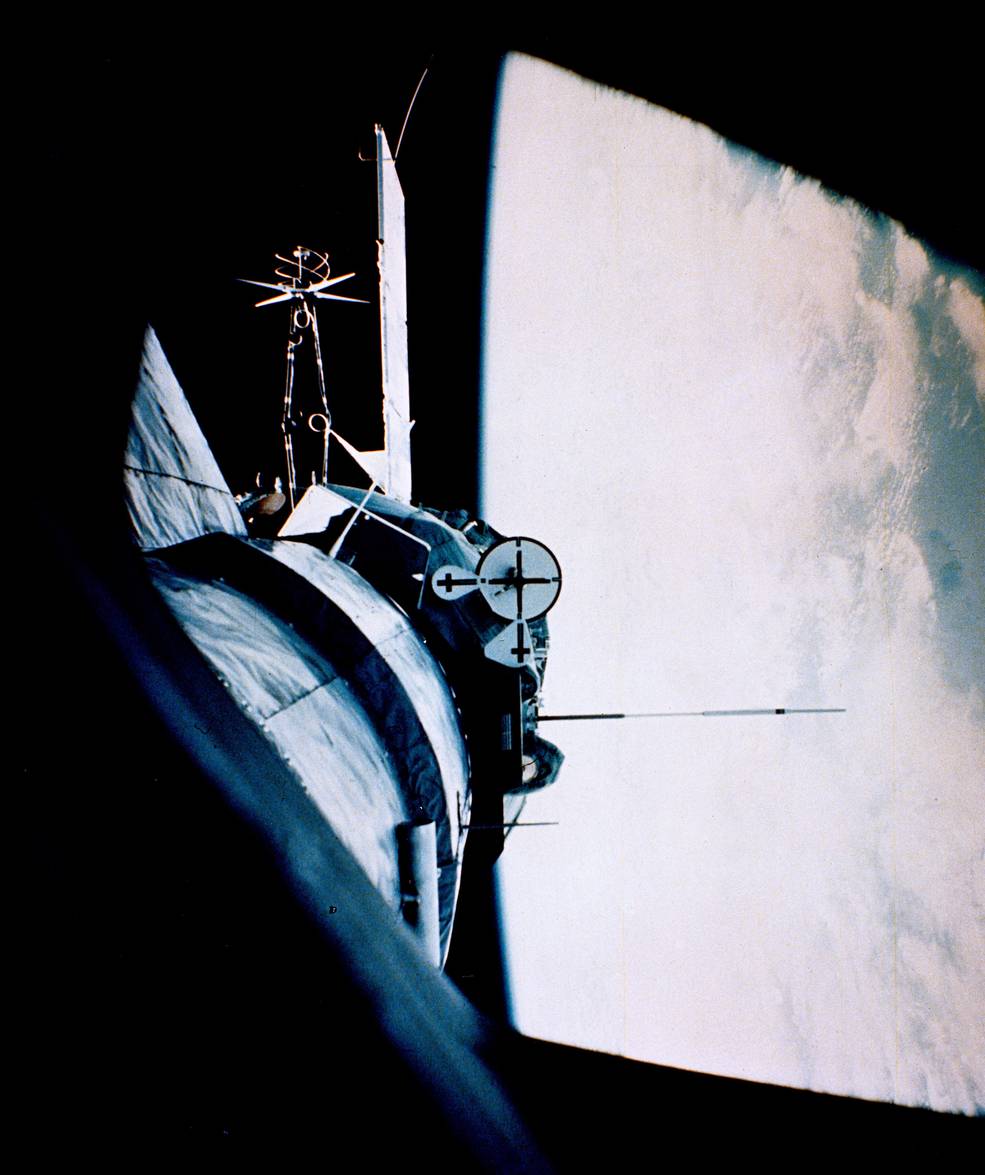
Left: Soyuz as seen from Apollo, shortly before the docking.
Middle: Apollo as seen from Soyuz, shortly before the docking.
Right: Soyuz and Apollo are docked, as seen from inside Apollo.
The Soyuz crew of Aleksei A. Leonov and Veleri N. Kubasov awoke first on the morning of July 17, followed shortly thereafter by the Apollo crew of Thomas P. Stafford, Vance D. Brand, and Donald K. “Deke” Slayton. By this time, less than 600 miles separated the two spacecraft and their crews. About two hours later, Stafford fired Apollo’s Service Propulsion System (SPS) engine for just over one second, the second maneuver in the rendezvous operation with Soyuz. Shortly after the successful burn, Brand reported that he could see Soyuz through Apollo’s sextant as “just a speck right now.” Soon after, the two crews established radio contact, making the following exchange with crewmembers speaking in the others’ language:
Stafford: Hello. Soyuz, Apollo. How do you read me?
Kubasov: Very well. Hello everybody.
Slayton: Hello, Valeri. How are you? Good day, Valeri.
Leonov: Apollo, Soyuz. How do you read me?
Slayton: Aleksei, I hear you excellently. How do you read me?
Leonov: I read you loud and clear.
Slayton: Good.
Pleasantries and communications checks complete, the crews buckled down to the business of completing the docking. Kubasov aboard Soyuz turned on the radar ranging transponder and Apollo locked on at a distance of about 125 miles. Apollo completed two more maneuvers with the SPS engine that brought the spacecraft within 22 miles of each other, followed by two additional burns using the smaller Reaction Control System (RCS) thrusters to refine the approach trajectory. Finally, Stafford used the RCS thrusters to slow Apollo’s approach to Soyuz. From Mission Control, Flight Director M.P. “Pete” Frank instructed Capsule Communicator (Capcom) Richard L. Truly to call up to the Apollo crew, “I’ve got two messages for you: Moscow is go for docking. Houston is go for docking. It’s up to you guys. Have fun.” As an extra precaution, Leonov and Kubasov retreated into the Soyuz Descent Module, and aboard Apollo, the crew closed the Command Module (CM) and Docking Module (DM) hatches. A color TV camera aboard Apollo, its signal routed through the ATS-6 communications satellite, showed the bright green Soyuz spacecraft growing larger as Apollo apporoached. Finally, Stafford eased Apollo toward Soyuz and called out, “Contact!” Leonov responded with, “Capture! Soyuz and Apollo are shaking hands now!”
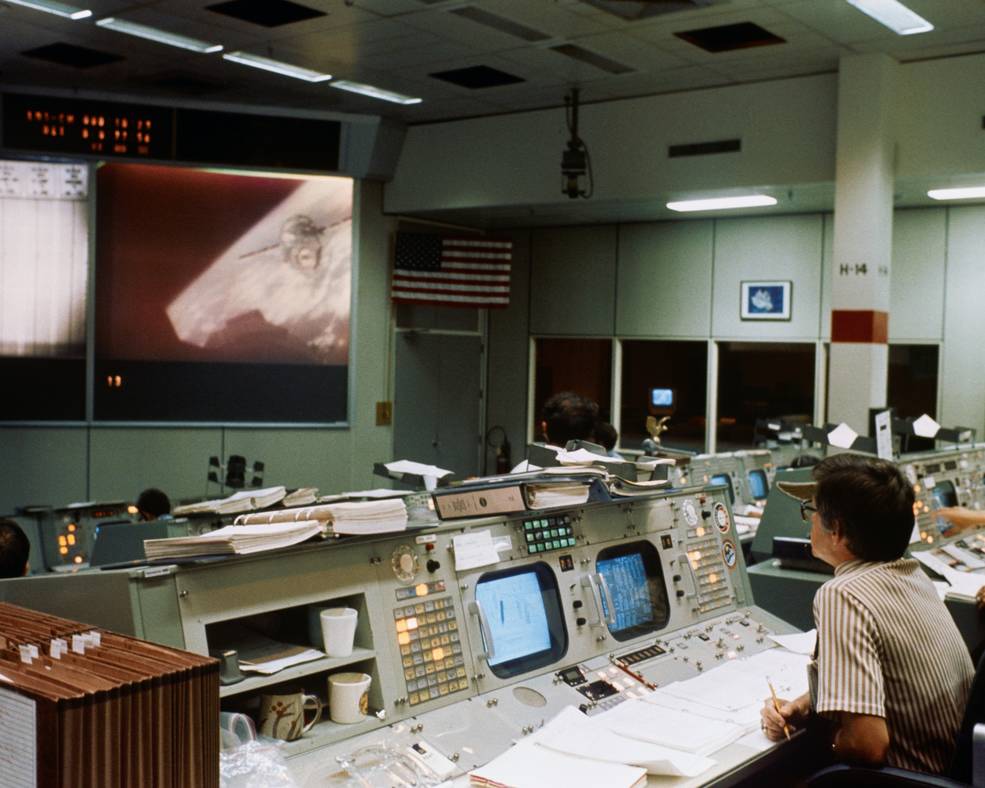
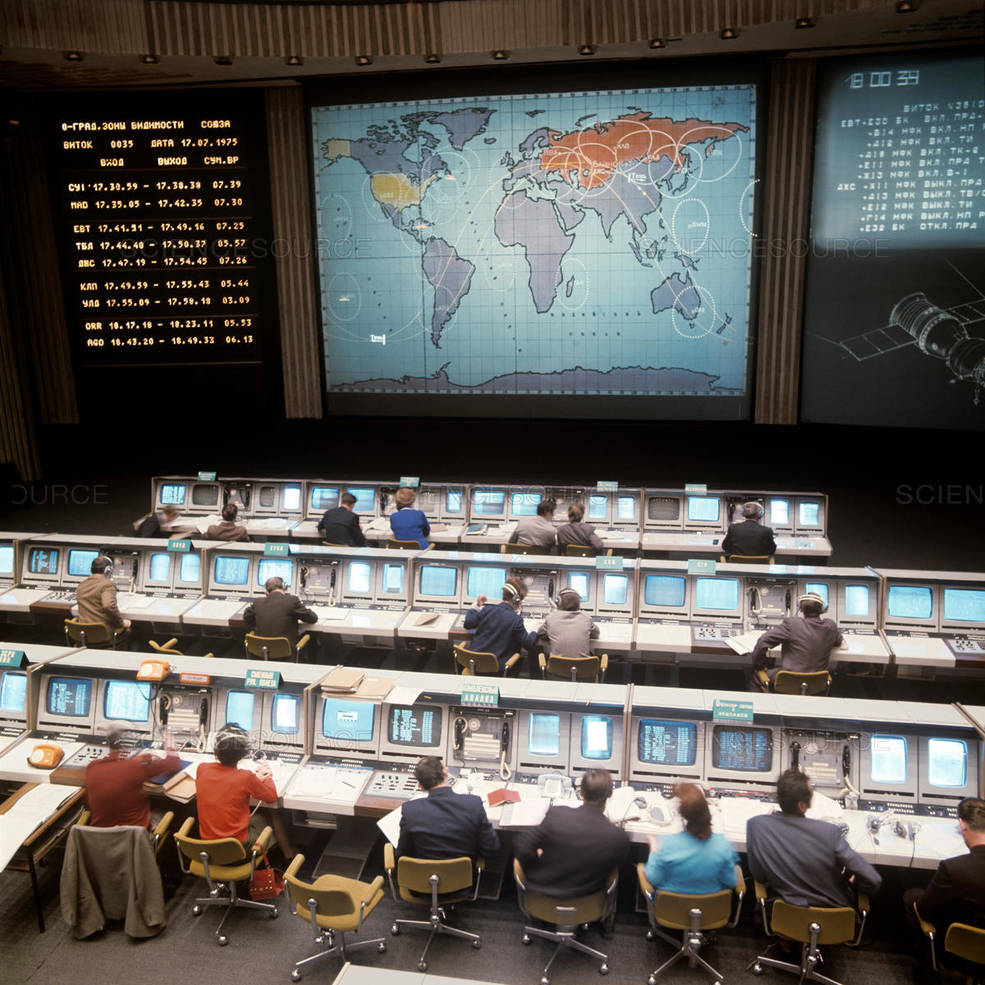
Left: Flight Director Frank in Mission Control at JSC during the rendezvous
and docking. Right: Flight Control Center in Kaliningrad.
Following the flawless docking, the astronauts and cosmonauts prepared for the first crew visit. When Slayton first opened the hatch to the DM, the smell of burnt glue greeted him, prompting the three Apollo crewmembers to reach for oxygen masks. Stafford alerted Leonov about the situation, but soon the spacecraft’s ventilation system along with mixing the air between the CM and the DM made the odor dissipate. For the first crew visit, Stafford and Slayton entered the DM, closed the two hatches leading to the CM and increased the pressure in the DM to match the pressure in Soyuz, using the DM as an airlock. On the Soyuz side, Leonov and Kubasov opened the hatch from the Soyuz Orbital Module to the DM, and shortly after, Stafford opened the final hatch between the DM and Soyuz. Stafford and Leonov met at the interface and shook hands, with Leonov saying, “Very good to see you!” and Stafford replying (in Russian), “Very happy, my friend!” From the Flight Control Center, a Soviet television announcer read a congratulatory message from Soviet leader Leonid I. Brezhnev to the joint ASTP crews. Stafford and Slayton then joined Leonov and Kubasov aboard Soyuz. A few minutes later, American President Gerald R. Ford called from the White House to congratulate the astronauts and cosmonauts on their great accomplishment.
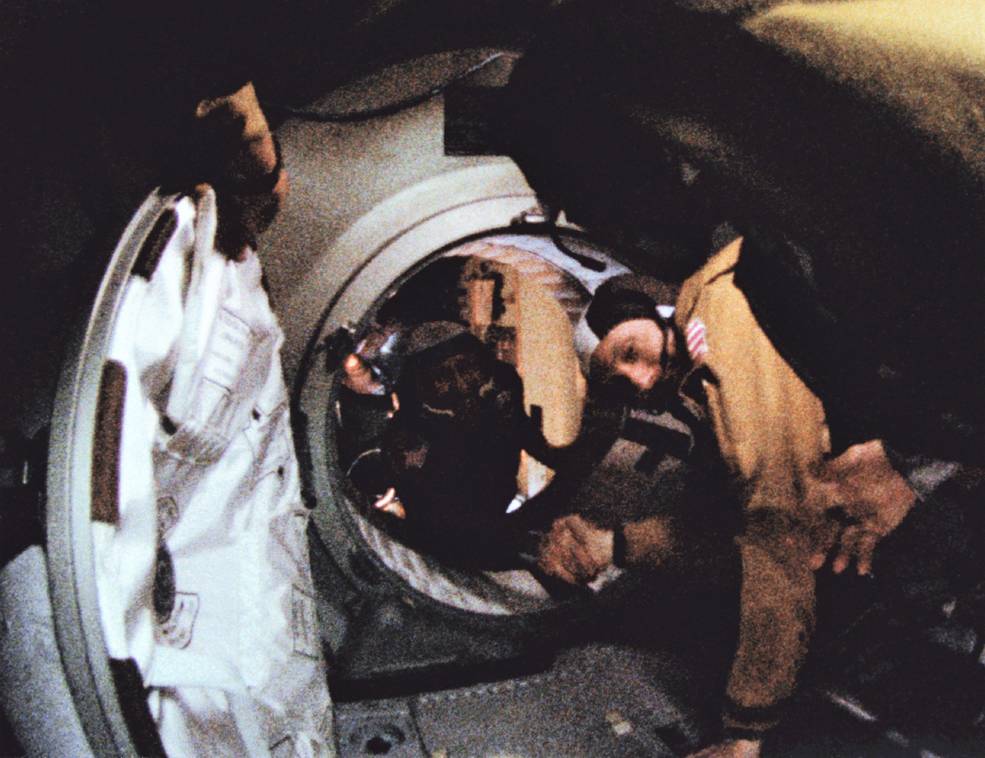
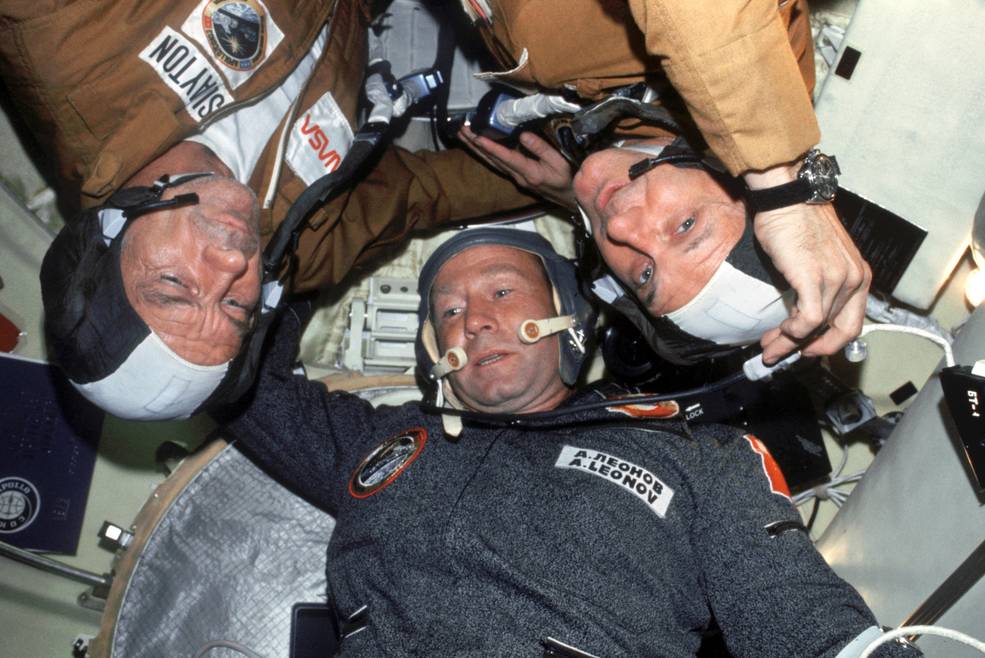
Left: The historic handshake in space between Leonov (left) and Stafford.
Right: During the first crew exchange (left to right) Slayton, Leonov, and
Stafford in the Soyuz Orbital Module.
Next came the first exchange of ceremonial gifts. On behalf of the US government and the American people, Stafford presented Leonov with five American flags for the Soviet government and people. Leonov reciprocated by handing Stafford Soviet flags as well as one of the United Nations. Stafford and Leonov joined together the two halves of a plaque, each portion of which launched separately aboard each spacecraft, and the crews signed formal certificates to authenticate the first international docking in space for the official records of the Fédération Aéronautique Internationale (International Aeronautical Federation).
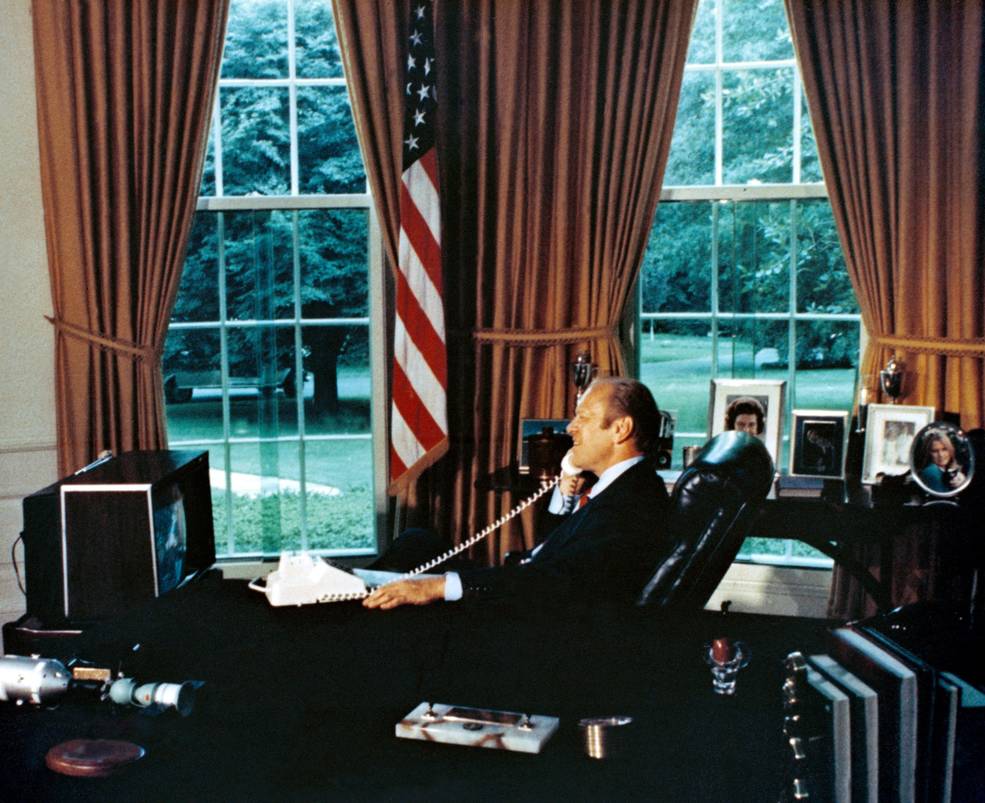
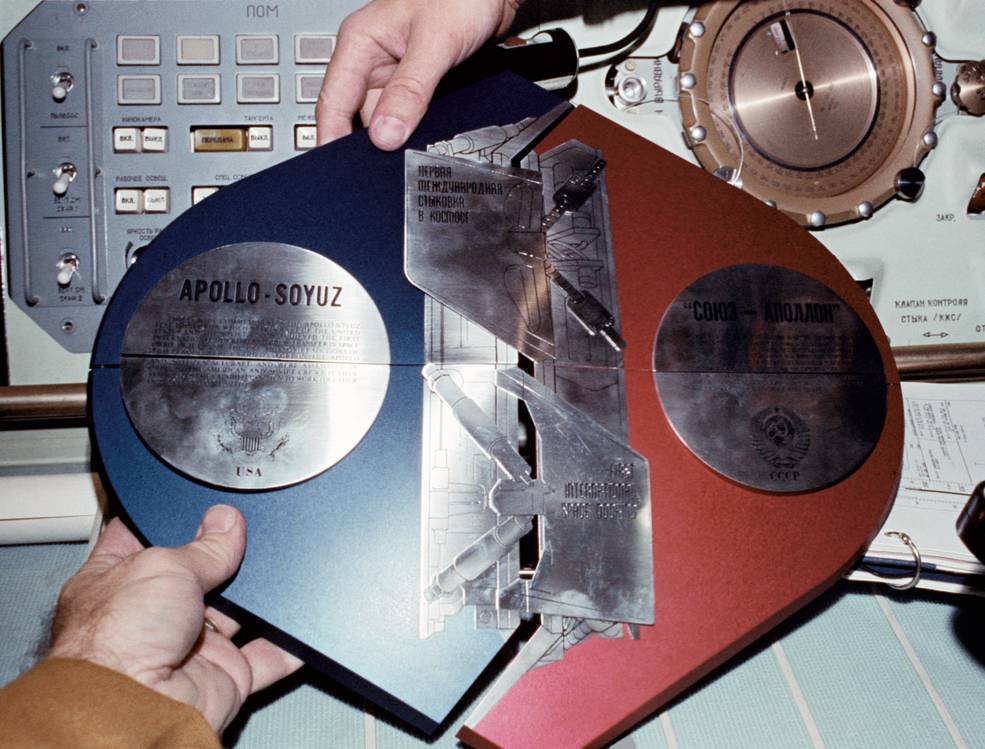
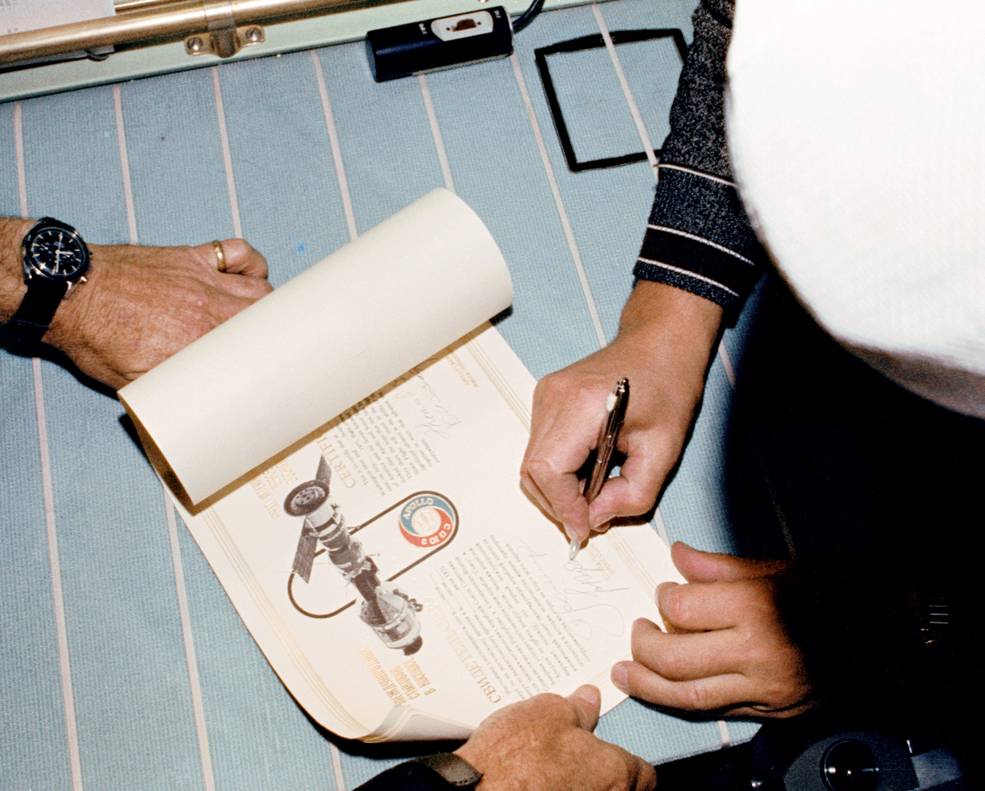
Left: President Ford congratulating the crew from the White House. Middle: Joining the two halves
of the ceremonial plaque. Right: Signing mission certificates aboard Soyuz.
When it was time for the four crewmembers to have their first meal together aboard Soyuz, Leonov had two surprises for Stafford and Slayton. Before launch, he had replaced the labels on tubes of borsch and blackcurrant juice with labels from Russian vodka bottles, giving Stafford quite a shock when Leonov offered them for a toast before starting the meal. For his second surprise Leonov, a budding amateur artist, presented Stafford and Slayton with sketches he had drawn of them during their various joint training sessions. After a very full day, Stafford and Slayton rejoined Brand aboard Apollo and the crews closed the hatches between the spacecraft and headed for a much-needed rest. The next day, Brand joined Kubasov aboard Soyuz and Leonov joined Stafford and Slayton aboard Apollo. Kubasov provided a televised tour of the Soyuz spacecraft and a travelogue from what they called the “Soviet-American TV center in space” as they flew over the Soviet Union. He and Brand filmed some science demonstrations to be later used in classrooms to demonstrate the effects of weightlessness. Stafford and Leonov provided TV viewers with a tour of the Apollo spacecraft. After the crews ate lunch, Brand returned to Apollo, Stafford and Leonov transferred to Soyuz, and Kubasov transferred into Apollo. From those positions, the five crewmembers conducted a press conference with reporters in Houston and in Moscow. Leonov, when asked about American space food, provided the following, “the best part of a good dinner is not what you eat, but with whom you eat.” Brand then provided Soviet TV viewers with a tour of the eastern United States, unfortunately mostly cloud-covered at the time of the event. Aboard Soyuz, Stafford presented to Leonov a box of superior spruce seeds prepared by the United States Department of Agriculture’s Forestry Service. The crews then said their final goodbyes and returned to their own spacecraft for their last sleep period of the docked phase.
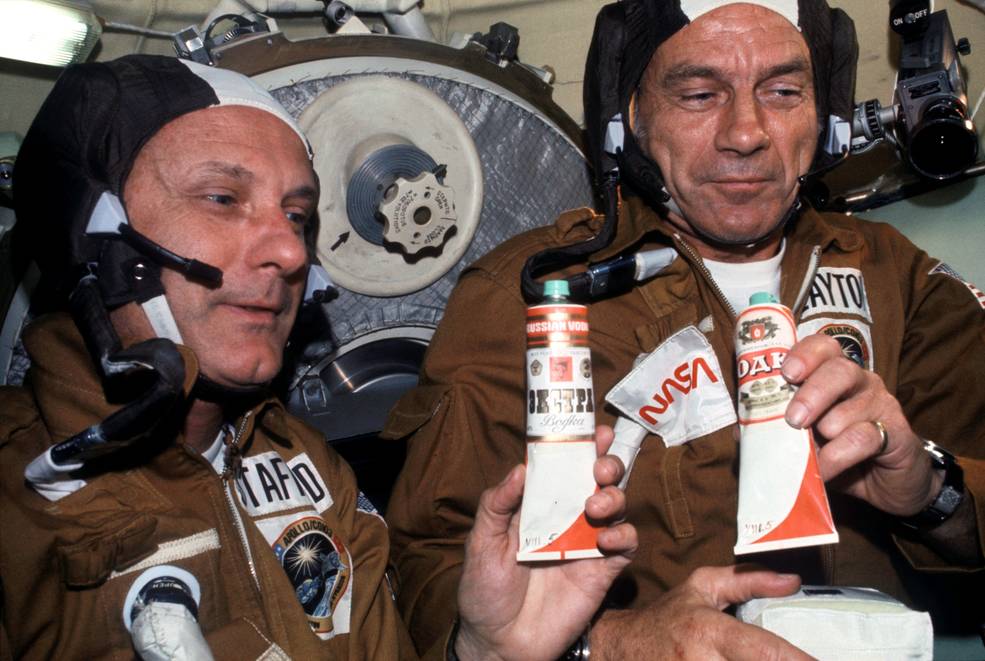
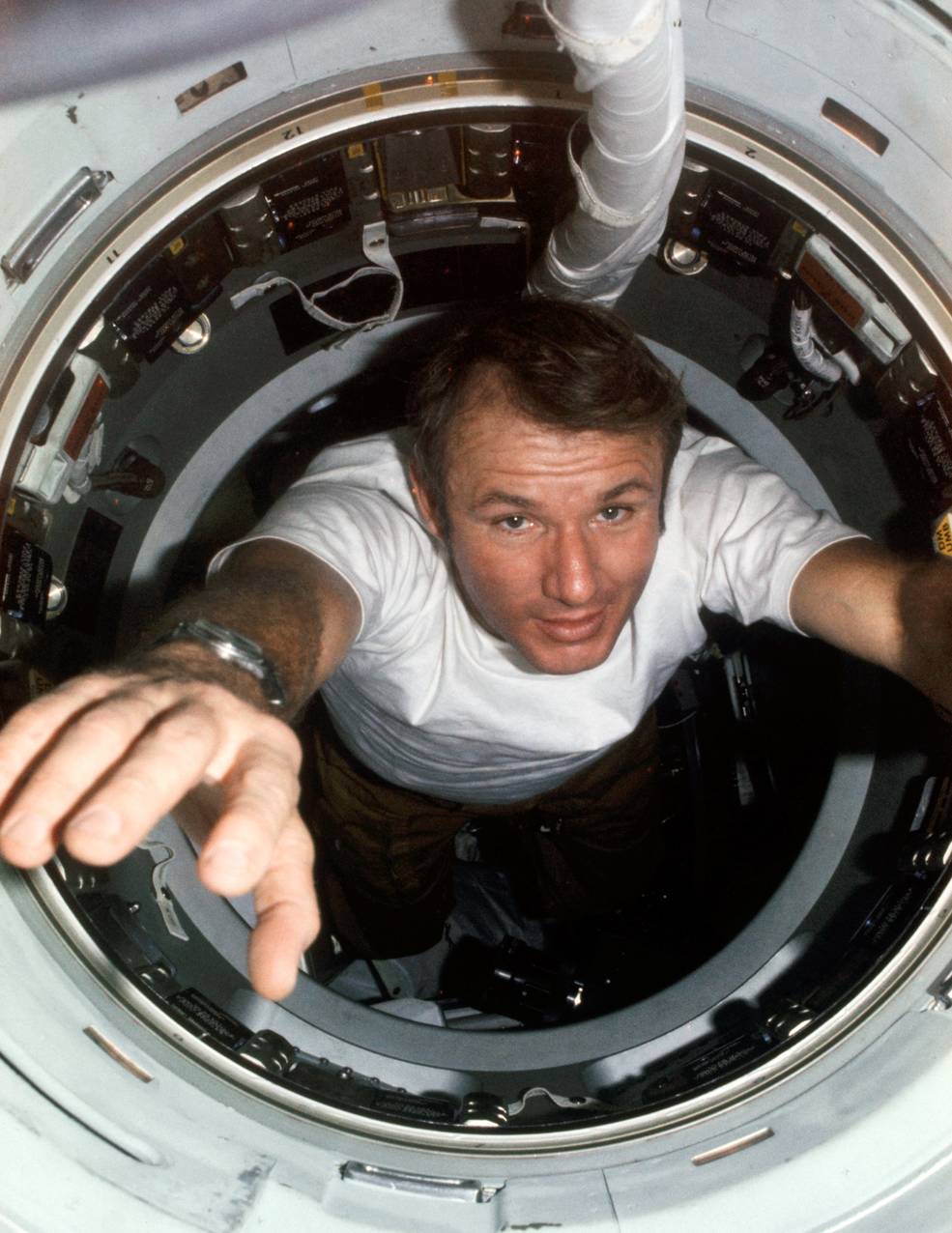
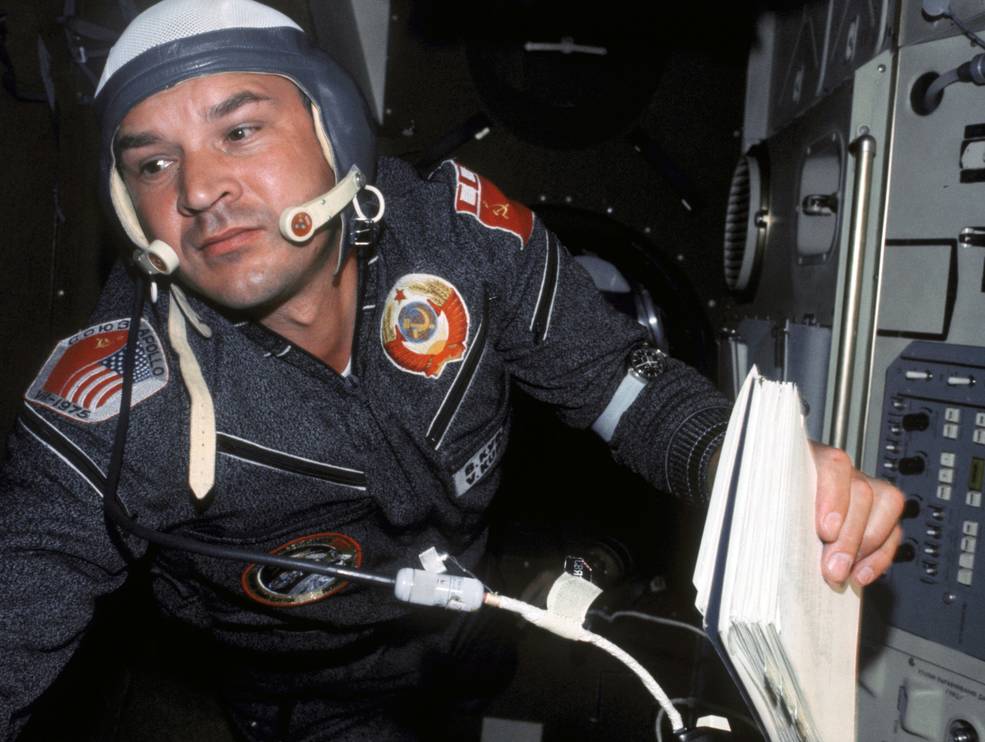
Left: Stafford (left) and Slayton enjoying Russian food aboard Soyuz.
Middle: Brand floating from Apollo into the DM.
Right: Kubasov aboard Soyuz.
The crews began their fifth day in space, July 19, with Apollo undocking from Soyuz and positioning itself between the Soviet spacecraft and the Sun to create an artificial solar eclipse as part of a joint experiment. Leonov and Kubasov photographed the solar corona. The experiment concluded, Slayton brought Apollo in for a second docking, with the Soyuz system in the active mode. Remaining docked for about three hours, Leonov then proceeded to control the second and final undocking of the two spacecraft. As part of the ultraviolet absorption (UVA) joint experiment to determine the quantities of atomic oxygen and atomic nitrogen at orbital altitudes, Slayton maneuvered Apollo around Soyuz and projected beams of monochromatic light onto the Soviet spacecraft on which were mounted retroreflectors. A spectrometer mounted on Apollo recorded the wavelength of the returned light beam. That second experiment complete, Apollo performed a six-second separation burn with its RCS thrusters and the two spacecraft went their separate ways, their two days of joint activities successfully completed. Soyuz stayed in orbit two more days while Apollo remained in space for five. The next time the crews would meet was in Moscow in September 1975 during a postflight goodwill tour of the Soviet Union.
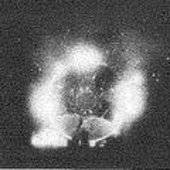
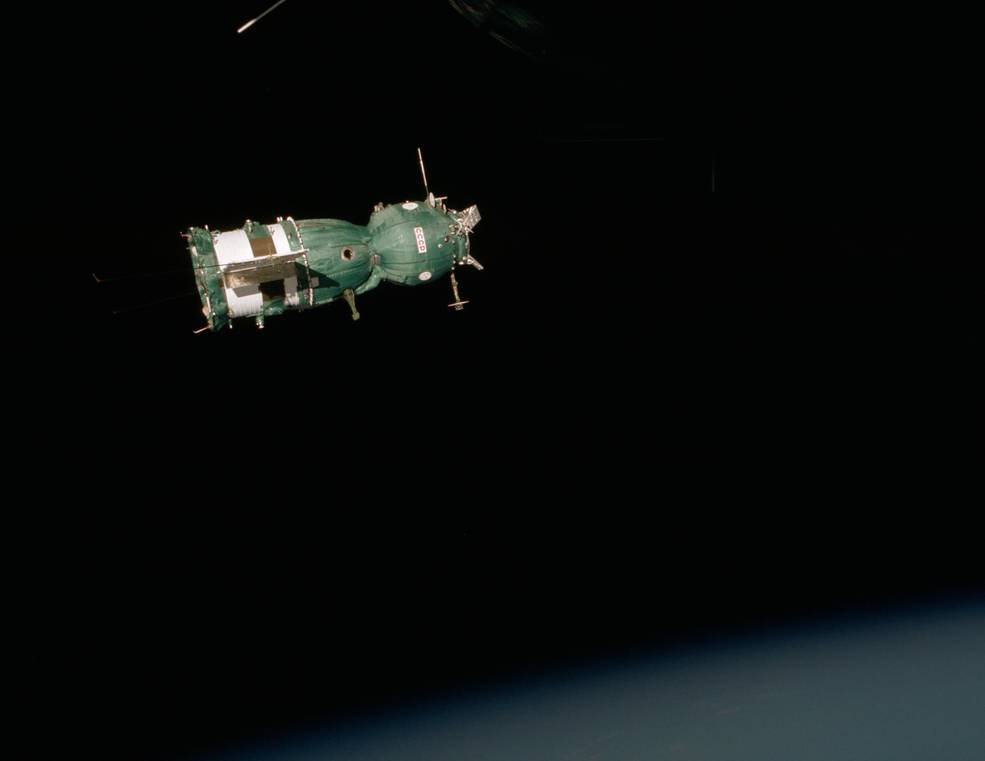
Left: View from Soyuz of Apollo and the solar corona during the artificial
solar eclipse experiment. Right: View from Apollo of Soyuz during the
UVA experiment.
To be continued…




























